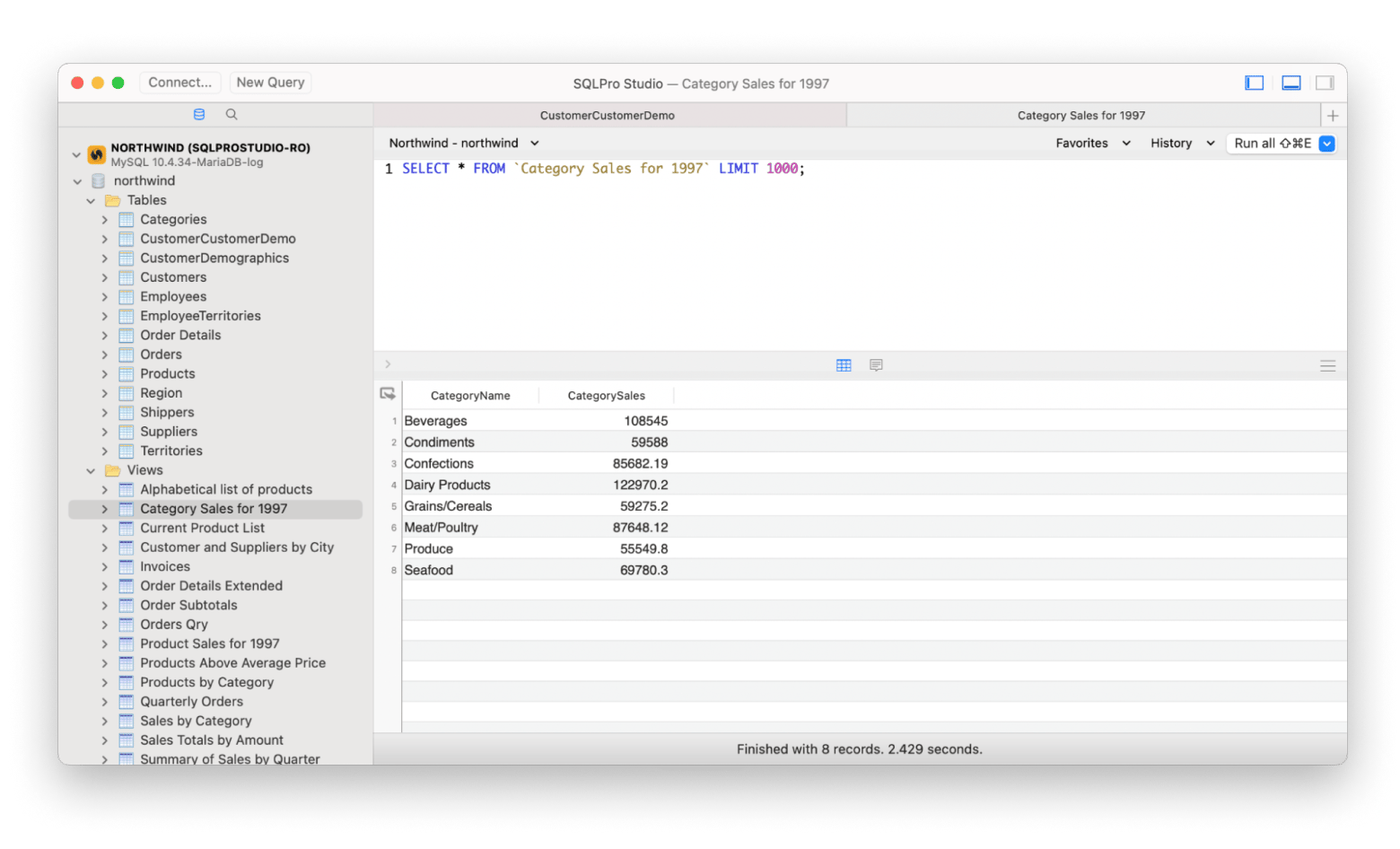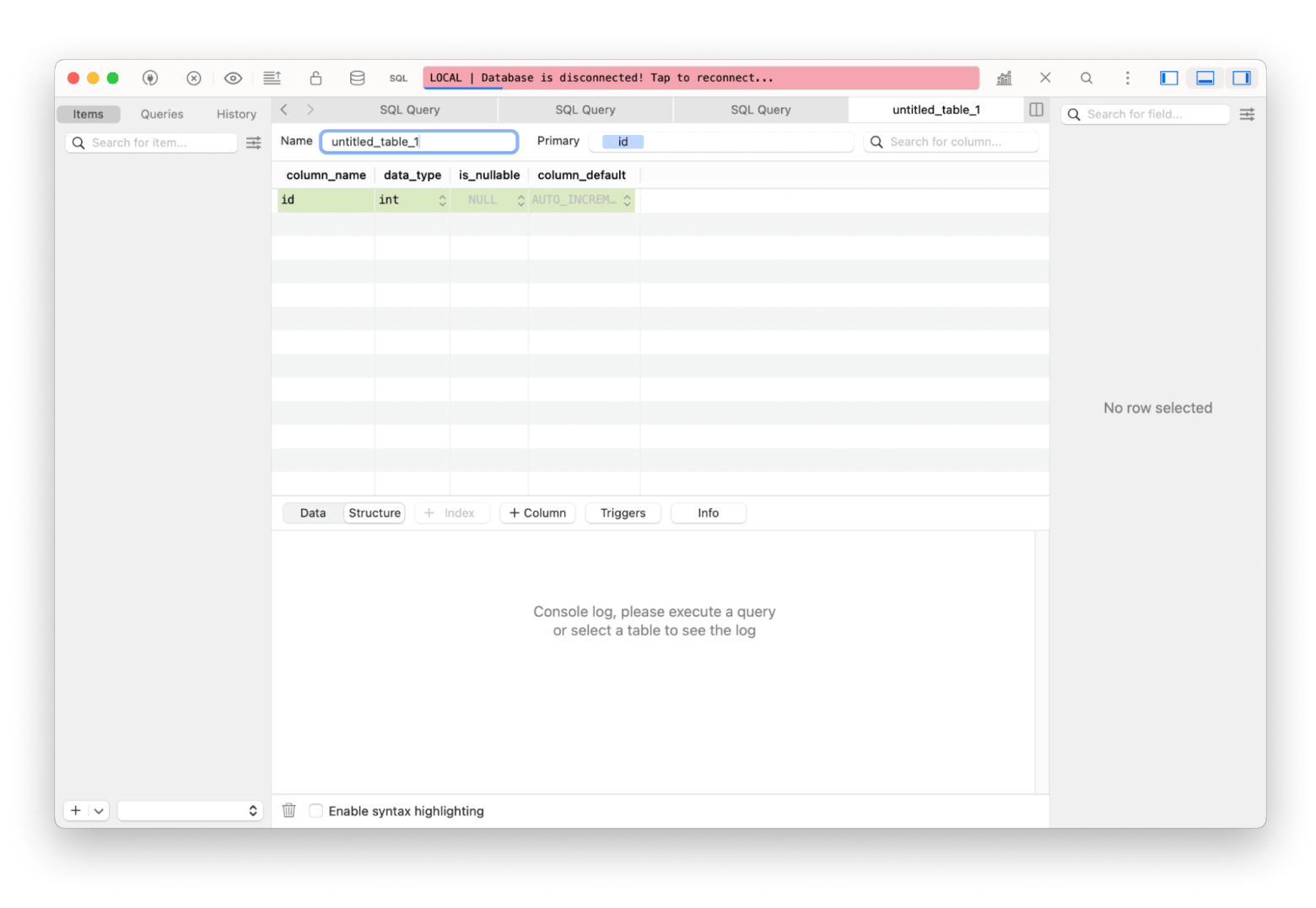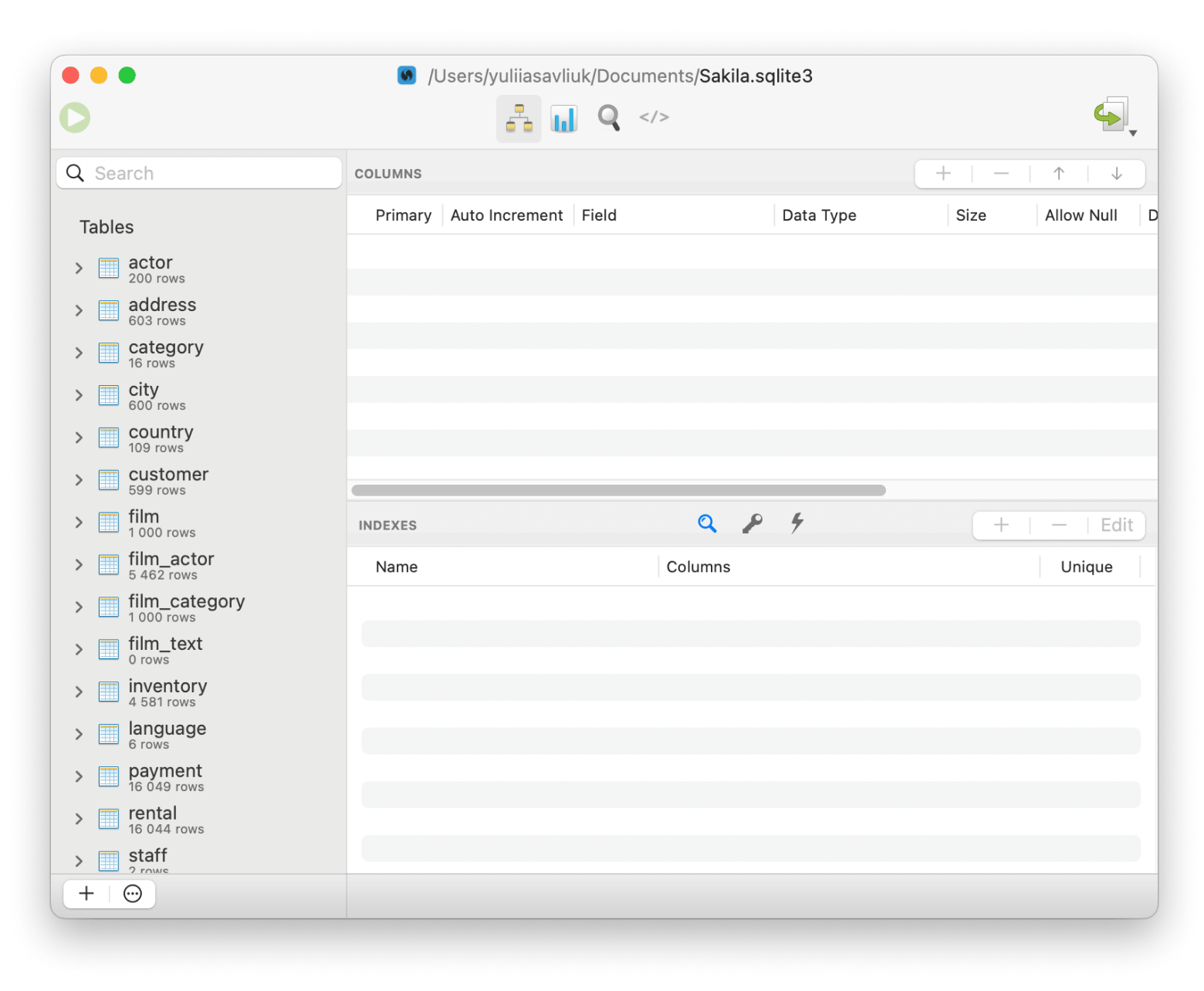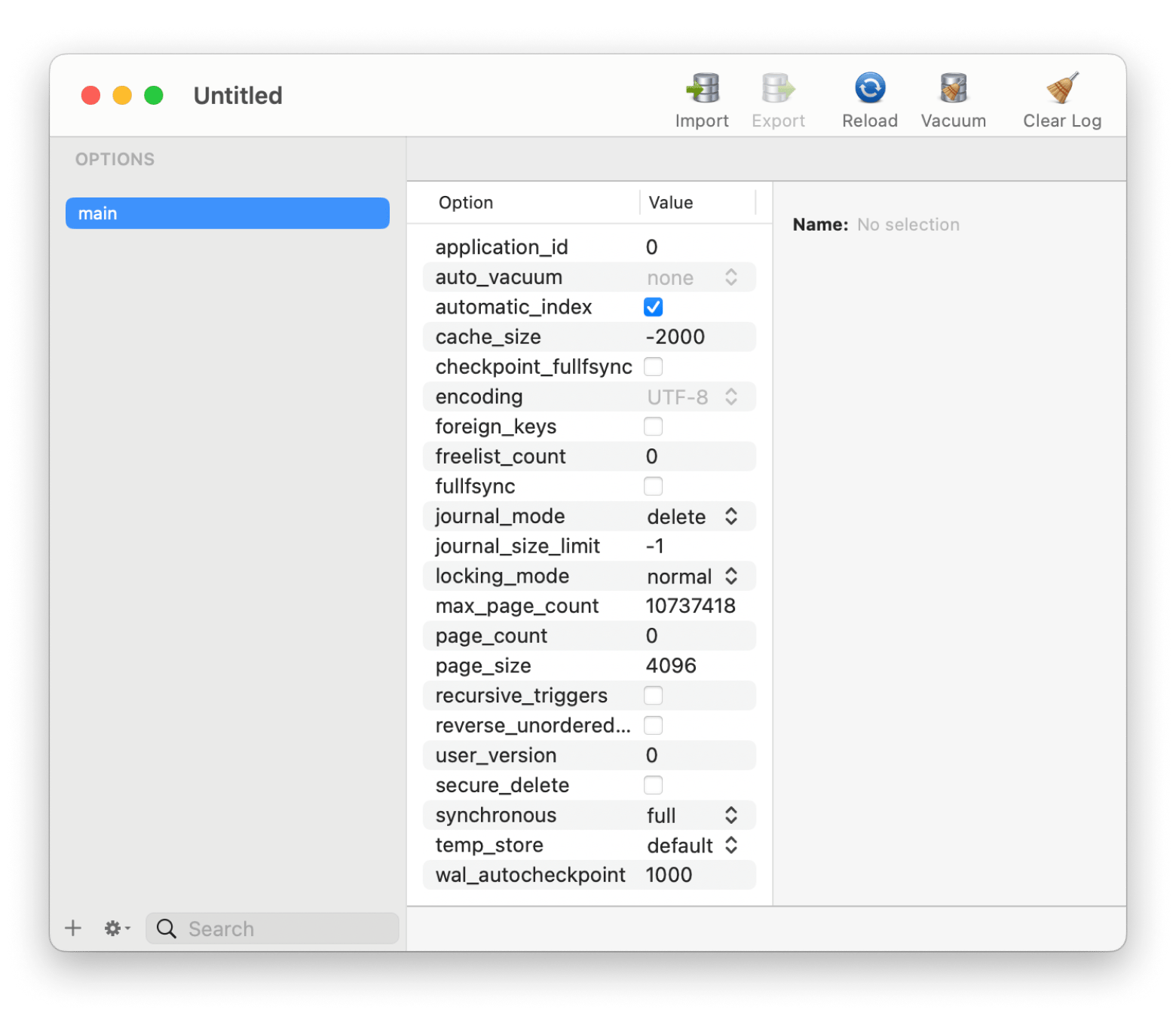7 top-rated database software for Mac users [My free & paid finds]
Choosing the best database software for Mac is tricky. Unfortunately, there aren't many tools that are optimized for macOS.
In this article, I'll walk you through some of the most powerful Mac database software that I have personally used and think is very helpful. The article is geared toward every developer, analyst, and database administrator who wants to find the right software for their needs.
Before we get started, let’s take a quick look at the seven database software I’ll be chatting about in this article.
| Let’s compare! | Price | Best for | Ease of use |
| SQLPro Studio | Included in Setapp* from $9.99/month + tax, along with over 260 other apps | Multi-database professionals | Easy UI |
| TablePlus | Included in Setapp* | Speed + customization seekers | Very intuitive |
| SQLPro for SQLite | Included in Setapp* | SQLite-focused developers | Beginner-friendly |
| Base | Included in Setapp* | Personal/simple project users | Very simple |
| LibreOffice Base | Free | Cross-platform & offline use | Moderate |
| PostgreSQL | Free | Advanced users & large datasets | Steep learning curve |
| DBeaver | Free (Community) / Paid (Pro) | Developers who need flexibility | Moderate |
*Setapp is a platform with 260+ apps for macOS, iOS, and web. Try it free for 7 days, then continue from $9.99/month + tax.
Key features to look for in database software for Mac
Not to sound like a broken record, but after personally testing and trying more than 20 database programs for Mac, I've found the most important features when choosing a Mac DB software are:
- Compatibility: The first and most crucial feature is to make sure the software is compatible with your Mac device. It should also integrate well with the other tools and apps you already use and love.
- User-friendliness: Software programs are meant to make our lives easier, and you don’t want to spend hours or days learning how to use one. So, choose intuitive software with a low learning curve so you can start building datasets on day one.
- Data security: Considering you'll be managing private data, you'll need a Mac DB software that comes with impressive security protocols. This can include data backups and recovery, encryption, and the ability to control data access.
- Scalability: The software should support your changing and growing needs. It should allow the database to scale up or down as needed without making big changes to the database structure.
- Pricing: Cost-effectiveness is everyone’s main consideration. Although you can find free database software for Mac, it’s worth spending a bit of money if that gives you access to advanced functionality. Also, look for tools that offer a free trial so that you can test them before purchasing.
- Cloud integration: Cloud-based software lets you access a database platform virtually anywhere with an internet connection. Plus, you won't have to worry about storage space or damage. All your data will be stored in the cloud and will be available anywhere online.
Consider these features carefully and see whether the software you have your eyes on checks all the boxes for your needs.
Top database software for Mac pros and everyday users
Now that we've explored the most important features to look for let’s check out the top-rated database programs for Mac. Hopefully, one of these options will be the perfect fit based on your needs, budget, and preferences.
SQLPro Studio: Reach features with multiple use cases

If you have to work with multiple database types at the same time, SQLPro Studio is the right option for you. It lets you view, store, and retrieve SQL server data with ease. You'll get a set of rich features for multiple use cases that make SQLPro Studio a valuable asset for data professionals and anyone needing a high-performance SQL editor.
I'm a fan of the tool because of its intuitive user interface, advanced query-building tools, diagramming, and schema comparison features that provide insights into complex data structures.
| What SQLPro Studio is known for | What does it mean |
| Supports major SQL database types | MySQL, SQLite, PostgreSQL, Microsoft SQL Server (2005 or higher), MariaDB, and Oracle (8i or +). Also integrates well with Git, Tableau, and Excel. |
| SQL formatter and validator | Get results for multiple tables at the same time — both messages and errors. |
| Single or multi-cell selection | No full-row selection is required. |
| Syntax management | Syntax highlighting, autocomplete, query error detection, beautifier of SQL queries. |
| Native Mac app | No need for Java to run it. Expect blazing speed, stable performance, lack of bugs, and zero hangups. |
| Cloud support | Supports major cloud database vendors, like Heroku, Amazon RDS, and Microsoft Azure. |
Woes I found:
- Limited customization options
- Large datasets may slow down the speed
Personally, I think the pros outweigh the cons. I highly recommend SQLPro Studio as the best native Mac Oracle client GUI.
TablePlus: Fast database management

TablePlus is another powerful, native database manager for Mac that supports all the latest macOS versions. Thanks to its easy-to-use interface, TablePlus makes database management easier, faster, and more efficient, and it's trusted by 100k+ developers worldwide.
What I like about this app is that it stands out with its friendly GUI, simplicity, and speed. You can customize it for appearance and configurations. Lightweight and minimal, TablePlus still packs the power and flexibility to tackle any challenge. The best thing is that you can create keyboard shortcuts to speed up your workflow.
| What TablePlus is known for | What does it mean |
| Compatible with many popular databases | PostgreSQL, MySQL, SQLite, MariaDB, MongoDB, ClickHouse, Turso, and more. |
| Inline edit | Edit data rows, table structure, or query results directly in one click. |
| Plug-and-play functionality | Extend the app’s functionality by installing third-party plugins. |
| Advanced filters | Quickly see the records you need. |
| Safe mode | Prevent mistakes and experiment with databases without risk. |
| Data import and export | Migrate a database to another server in no time. |
Woes I found:
- Performance issues with large datasets
- Steep learning curve
Still, if you’re looking for a fast, flexible, and visually clean database tool for macOS, TablePlus is worth a try.
SQLPro for SQLite: Multiple queries at a time

SQLPro for SQLite is my go-to database management tool for handling SQLite. I recently used it to optimize query data for a high-traffic API, which made debugging much easier.
The app allows for efficient query management; you can save frequently used queries and access the history of recent ones. You can even highlight favorite queries to reduce boring, repetitive work.
It makes query creation and management easier and error-free, even for beginners. I highly recommend it for developers who need a reliable and versatile solution for working with multiple database systems.
| What SQLPro for SQLite is known for | What does it mean |
| Customize tables and table schemes | Access, view, and edit tables, foreign keys, triggers, or indexes. |
| Syntax highlighting and query autocomplete | Avoid errors and make queries readable. |
| Multi-query execution | Run multiple queries and see results for different tables at the same time and in one place. |
| Data filtering and sorting | Quickly edit with the inline table editor and apply hex viewing with the row editor. |
| Data import and export | Export to CSV, MySQL, XML, or JSON for easy sharing. |
| Full integration support | Easily roll back to the previous state of your SQLite database. |
Woes I found:
Limited customizability
Even with that downside, SQLPro for SQLite is still a great pick if you want something easy to use and reliable.
Base: Simple SQLite file management

One database software that I often use for my projects is Base. This Mac database tool has a user-friendly interface, perfect for creating sales reports, tracking assets, invoices, and more.
Its full HSQL relational database engine provides full support for SQL queries. Base is a lightweight yet powerful software that offers support drivers for various multi-user database engines, including MySQL, Adabas D, MS Access, and PostgreSQL. Also, you can control your information easily with the centralized admin control panel.
| What Base is known for | What does it mean |
| Custom mapping for different industries | Add custom fonts and markers to tailor the tables or maps. |
| Syntax highlighting and query autocomplete | Avoid errors and streamline the process of writing SQL queries. |
| Multi-query execution | Run multiple queries and get results at the same time. |
| Easy set up | Using Base requires no technical knowledge. |
| Easy sharing | Export to CSV, MySQL, or other formats for easy sharing. |
| Full integration support | Apache OpenOffice suite applications. |
Woes I found:
- Limited advanced features
- For heavy traffic applications, the base may lack speed
Overall, Base is a solid option if you need something simple, lightweight, and efficient for everyday database tasks on Mac.
Read also:
- Manage Multiple Databases With Tableplus
- Use Go With MySQL
- SQL Server Management Studio Alternatives for Mac
- Delete Duplicate Files With Gemini
Best free database software for Mac that gets the job done
If you're on a tight budget or don’t need advanced features, you’re in luck. There are some great free Macintosh database applications you can try.
Let's look at three free options.
LibreOffice Base: Powerful database manager
LibreOffice Base is one of the best programs I’ve ever tried, and you can get it for free. This app offers most of the features you need to design and manage databases.
You'll get data integrity features like validation rules and referential integrity constraints. Additional features include advanced query functions like joins, aggregates, and subqueries. What’s more, LibreOffice Base seamlessly integrates with LibreOffice applications like Calc and Writer for extended functionality.
| What LibreOffice Base is known for | What does it mean |
| Multi-database support | Compatible with various database engines such as MySQL, PostgreSQL, and Microsoft Access. |
| Built-in HSQLDB | Suitable for standalone database applications. |
| Form Design Wizard | Create forms with a step-by-step wizard. |
| Report Builder | Design and generate detailed reports from data. |
| Data import and export | Supports various formats, including CSV, Excel, and XML. |
| Cross-platform compatibility | macOS and Linux for broad accessibility. |
Woes I found:
- Dated and slightly clunky interface
- Slow for larger datasets
- Compatibility issues with macOS-specific features
- Requires Oracle’s Java Development Kit to work
- Limited customizability
So, if you're working on basic to intermediate projects and need a free, full-featured database tool that works well across platforms, LibreOffice Base is a solid choice.
PostgreSQL: Advanced open-source database
PostgreSQL is a reliable open-source object-relation database software that can easily handle complex and large data. Professionals will enjoy using its advanced features, including complex SQL queries, foreign keys, triggers, and multi-version concurrency control (MVCC).
The software provides robust support for handling transactional data with integrity and efficiency. It’s easy to set up for running queries, and you can quickly restore data with its backup and recovery features.
| What PostgreSQL is known for | What does it mean |
| Customization available for developers | Create custom functions, data types, and operators. |
| Advanced query and SQL features | Supports complex joins, subqueries, window functions, and common table expressions (CTEs). |
| Internationalization, text search | Support for international character sets, case-insensitive and accent-insensitive collations. |
| Defined APIs | Build an application with PostgreSQL to solve your challenges. |
Woes I found:
- It can be challenging for beginners
- Optimization for peak performance can be time-consuming
That said, if you’re comfortable with a bit of a learning curve, PostgreSQL offers the power and flexibility you need for serious database work.
DBeaver: Universal database tool
DBeaver is another complete, on-source database software for Mac that works with all popular SQL databases. It’s a powerful SQL editor that supports complex functions like setting relations and primary keys. This simple database for Mac has an intuitive user interface that lets you navigate through different functions like a pro. Also, you can expect fast query execution with consistently accurate results.
The free Community version lets you connect to most major database engines and handle everyday data tasks with ease. If you're working in a large-scale enterprise, the Pro (Commercial) version offers even more advanced features.
| What DBeaver is known for | What does it mean |
| Multi-Database Support | MySQL, SQL Server, PostgreSQL, and more. |
| Schema management tools | Supports schema migration and monitoring of database connection sessions. |
| Query result pane | Filter results and store them in different formats for query generation. |
Woes I found:
- Multiple tabs when retrieving a table can feel confusing
- May seem overcrowded with features
All in all, if you’re looking for a flexible, feature-rich database tool that grows with your needs, DBeaver is a great choice, especially if you're a developer who likes having everything in one place.
Choosing the best Mac database software
When choosing the right database software, you don't just need to consider the features and price. You need to see whether the tool fits into your workflow. The choice can make or break your productivity. The best way to make a good decision is to choose database software based on the scale of your data and your unique requirements.
Some Macintosh database applications like SQLPro Studio and TablePlus are perfect for large-scale enterprise applications, while others likeBase are ideal for simpler, personal projects.
Don’t forget to consider the ease of use. Some tools, like Base, are incredibly user-friendly and don’t require deep technical knowledge, while tools likeSQLPro for SQLite are geared more toward developers.
You don't have to opt for just one! The good news is that all four apps are available on Setapp. It's an all-in-one service that gives you access to a curated collection of top Mac and iOS apps, perfect for getting things done, staying creative, and managing daily tasks with ease. You can try these apps with the 7-day free trial.
FAQ
What's the best database software for Mac?
The best database software for Mac is the one that fits your needs and budget. But solid performance doesn’t have to be expensive. There are affordable options that work great for smaller projects that don’t need advanced features.
Can I create a database on a Mac?
Yes, you can create a database on a Mac. There are built-in and third-party apps for everything from basic to advanced and enterprise-level needs. Some of these apps include SQLPro Studio, TablePlus, SQLPro for SQLite, and Base.
Can I run an Access database on a Mac?
No, you can’t run Microsoft Access on a Mac. That’s because most business users still rely on Windows, and the number of Mac users in that space is relatively low, so Microsoft hasn’t developed a Mac version of Access.






